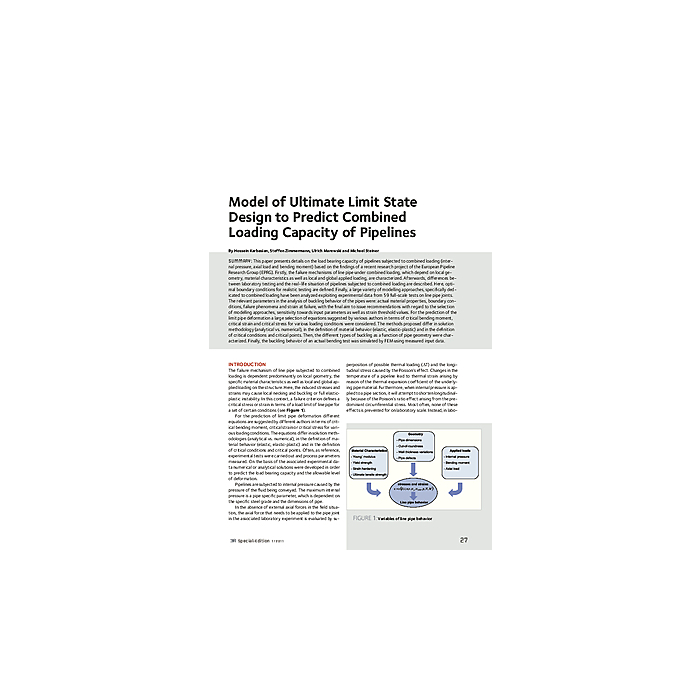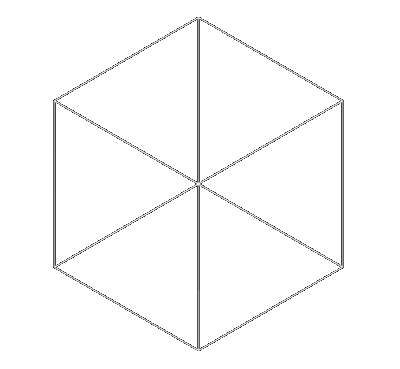Model of Ultimate Limit State Design to Predict Combined Loading Capacity of Pipelines
4,90 €
Auf Lager
Artikelnummer
01252_2011_SP1_04
SUMMARY: This paper presents details on the load bearing capacity of pipelines subjected to combined loading (internal pressure, axial load and bending moment) based on the findings of a recent research project of the European Pipeline Research Group (EPRG). Firstly, the failure mechanisms of line pipe under combined loading, which depend on local geometry, material characteristics as well as local and global applied loading, are characterized. Afterwards, differences between laboratory testing and the real-life situation of pipelines subjected to combined loading are described. Here, optimal boundary conditions for realistic testing are defined. Finally, a large variety of modelling approaches, specifically dedicated to combined loading have been analyzed exploiting experimental data from 59 full-scale tests on line pipe joints. The relevant parameters in the analysis of buckling behavior of the pipes were: actual material properties, boundary conditions, failure phenomena and strain at failure, with the final aim to issue recommendations with regard to the selection of modelling approaches, sensitivity towards input parameters as well as strain threshold values. For the prediction of the limit pipe deformation a large selection of equations suggested by various authors in terms of critical bending moment, critical strain and critical stress for various loading conditions were considered. The methods proposed differ in solution methodology (analytical vs. numerical), in the definition of material behavior (elastic, elastic-plastic) and in the definition of critical conditions and critical points. Then, the different types of buckling as a function of pipe geometry were characterized. Finally, the buckling behavior of an actual bending test was simulated by FEM using measured input data.
| Autoren | Hossein Karbasian/Steffen Zimmermann, Ulrich Marewski and Michael Steiner |
|---|---|
| Erscheinungsdatum | 30.04.2011 |
| Format | |
| Zeitschrift | 3R - Special 1 2011 |
| Verlag | Vulkan-Verlag GmbH |
| Sprache | English |
| Seitenzahl | 7 |
| Titel | Model of Ultimate Limit State Design to Predict Combined Loading Capacity of Pipelines |
| Beschreibung | SUMMARY: This paper presents details on the load bearing capacity of pipelines subjected to combined loading (internal pressure, axial load and bending moment) based on the findings of a recent research project of the European Pipeline Research Group (EPRG). Firstly, the failure mechanisms of line pipe under combined loading, which depend on local geometry, material characteristics as well as local and global applied loading, are characterized. Afterwards, differences between laboratory testing and the real-life situation of pipelines subjected to combined loading are described. Here, optimal boundary conditions for realistic testing are defined. Finally, a large variety of modelling approaches, specifically dedicated to combined loading have been analyzed exploiting experimental data from 59 full-scale tests on line pipe joints. The relevant parameters in the analysis of buckling behavior of the pipes were: actual material properties, boundary conditions, failure phenomena and strain at failure, with the final aim to issue recommendations with regard to the selection of modelling approaches, sensitivity towards input parameters as well as strain threshold values. For the prediction of the limit pipe deformation a large selection of equations suggested by various authors in terms of critical bending moment, critical strain and critical stress for various loading conditions were considered. The methods proposed differ in solution methodology (analytical vs. numerical), in the definition of material behavior (elastic, elastic-plastic) and in the definition of critical conditions and critical points. Then, the different types of buckling as a function of pipe geometry were characterized. Finally, the buckling behavior of an actual bending test was simulated by FEM using measured input data. |
Eigene Bewertung schreiben


